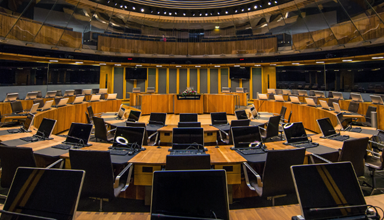The Senedd could be on the verge of its biggest shake-up since it was established in 1999 if the Senedd Cymru (Members and Elections) Bill becomes law.
The Bill was introduced this week and would see the number of Members of the Senedd increase, as well as change the way they are elected.
This article looks at the Bill and how it will be scrutinised.
What are the main proposals?
The Bill takes forward most of the recommendations made by the Special Purpose Committee on Senedd Reform, which reported in May 2022. You can read more about the Committee’s conclusions in this Senedd Research article.
The headline changes being made by the Bill include:
- Increasing the number of Members of the Senedd from 60 to 96;
- Introducing a closed-list proportional electoral system to elect Members;
- A return to the Senedd being elected for four-year terms;
- Enabling the Senedd to elect a second Deputy Presiding Officer;
- Increasing the maximum number of Welsh Ministers from 12 to 17 (with potential to increase to 19);
- Putting provisions in place for reviews of Senedd constituency boundaries to be undertaken; and
- Making it a requirement for candidates to, and Members of, the Senedd to be registered to vote at an address in Wales.
The Bill does not include two major reforms proposed by the Special Purpose Committee to improve diversity in the Senedd – to introduce gender quotas for candidates and to collect and publish candidate diversity information. These will be taken forward in a separate Bill expected later this year.
The Bill also requires the Llywydd to propose a committee be set up to look at whether certain positions in the Senedd could be filled through ‘job-sharing’. A motion proposing this committee would need to be laid within six months of the first meeting of the Senedd after the 2026 election.
What has the Welsh Government said about the Bill?
Introducing the Bill, the Counsel General and Minister for the Constitution, Mick Antoniw MS, said:
It presents us and the people of Wales with a once-in-a-generation opportunity to make the changes necessary to modernise the Senedd, reflecting our 21st Century Wales. A more effective Senedd, with the ability and capacity to hold the Welsh Government to account. A more representative Senedd to better serve the people of Wales.
How will the Bill be scrutinised?
The Reform Bill Committee was established on 12 July 2023 and will lead the Stage 1 scrutiny of the Bill.
As per the standard legislative process, the Bill will also be scrutinised by the Finance Committee (focusing on the financial implications of the Bill) and the Legislation, Justice and Constitution Committee, who will look at the quality and legality of the legislation.
If the Bill’s general principles are agreed at Stage 1, it will then proceed through the rest of the legislative process before reaching a final vote at Stage 4.
This is where things differ to Bills usually considered by the Senedd.
Some of the provisions of the Bill, like changing the number of constituencies and how Members are elected, relate to what are called “protected subject-matters”. This means that the Bill must have the support of two-thirds of Members of the Senedd for it to become law. This is known as a ‘supermajority’.
What should you look out for next?
The Reform Bill Committee will hold its first evidence session with the Counsel General and Minister for the Constitution, before hearing from key stakeholders over the coming months.
You can follow proceedings on the Committee’s website and Senedd.tv.
You can also find more Senedd Research publications about the Bill and the history of Senedd Reform on this resource page, which will be updated as the Bill progresses.
Part 1 makes provision to increase the number of Members of the Senedd to 96, by amending the number of constituencies and the number of seats for each constituency.
It also sets out how Senedd constituencies would be defined, and changes the frequency of ordinary general elections to every four years.
It increases the maximum number of Deputy Presiding Officers that can be elected from 1 to 2, and increases the maximum number of Welsh Ministers from 12 to 17 (with a power to increase further to 19).
People who are not registered on the register of local government electors in Wales would be disqualified from being a Member of the Senedd, or a candidate in an election to the Senedd by this Part.
It also requires the Llywydd of the next Senedd, elected after April 2026, to propose a motion to establish a Senedd committee to look at the possibility of job-sharing roles in the Senedd.
This Part changes the electoral system used to elect Members of the Senedd to a Closed-List Proportional System using the D’Hondt formula. Our glossary explains these terms in more detail.
In short, it allows for political parties to submit lists of eight candidates to stand in a constituency and for individual candidates (independents) to also put themselves forward. Voters would be able to vote for a political party’s list or for an independent candidate at the ballot box.
Vacancies in seats that occur between Senedd general elections would be filled from the next eligible candidate on the party’s list. The seat would remain vacant until the next general election if the list is exhausted or if it’s an individual candidate.
Part 3 renames the Local Democracy and Boundary Commission for Wales as the Democracy and Boundary Commission Cymru.
This name change reflects additional responsibilities given to the Commission by this Bill for reviewing Senedd election boundaries. It is currently only responsible for reviewing the boundaries for local government elections in Wales.
This Part also includes:
- Increasing the maximum number of members of the Commission, and empowers the Welsh Ministers to change the quorum for meetings of the Commission; and
- New restrictions on Members of the Senedd, their staff or Senedd Commission staff from being members, the chief executive or an assistant commissioner to the Commission.
This Part provides for boundary reviews to take place in two circumstances:
- Before the first general election held after 6 April 2026; and
- For General elections held after 1 April 2030.
These provisions are set out in Schedules 1 and 2 of the Bill.
This Part requires the Llywydd to table a motion after the 2026 election, to propose the establishment of a Senedd committee to review the operation of Parts 1 and 2 of the Bill.
The remaining provisions in this Part relate to powers to make consequential and transitional provisions, the procedures to be applied to secondary legislation provided for in the Bill, and provisions about it coming into force.
Schedule 1 provides for the new Democracy and Boundary Commission Cymru to carry out a review to establish new Senedd constituencies in time for the first general election to be held after 6 April 2026. The Commission would be required to ‘pair’ two UK parliamentary constituencies to form each of the 16 Senedd constituencies for the 2026 election.
The Schedule sets out the procedure and parameters that the Commission must follow when conducting this review.
Schedule 2 makes provision for the Democracy and Boundary Commission Cymru to carry out a review of Senedd constituency boundaries before the first Senedd general election to be held after 1 April 2030, and subsequently every eight years.
It sets out the procedure and parameters that the Commission must follow when conducting its reviews.
This article highlights the main features of the Bill only and isn’t intended to be exhaustive. We’ll publish a comprehensive Bill summary in due course. Refer to the Bill and its explanatory notes for full detail.
Article by Josh Hayman, Senedd Research, Welsh Parliament






